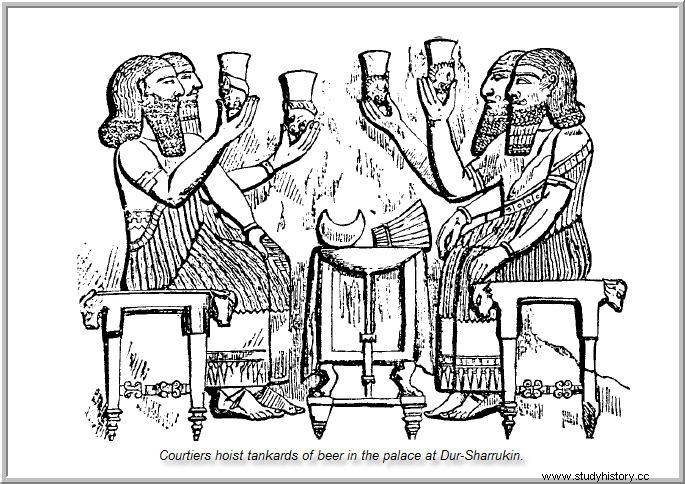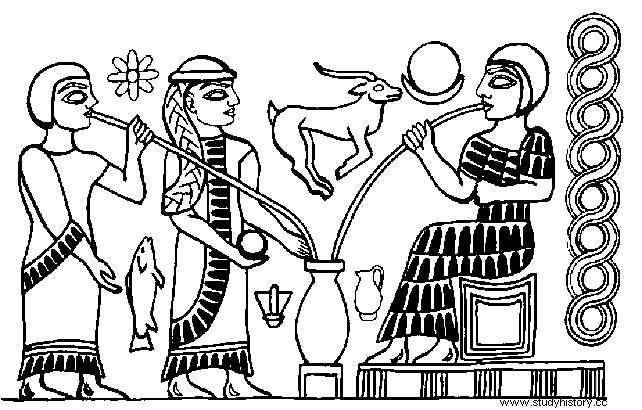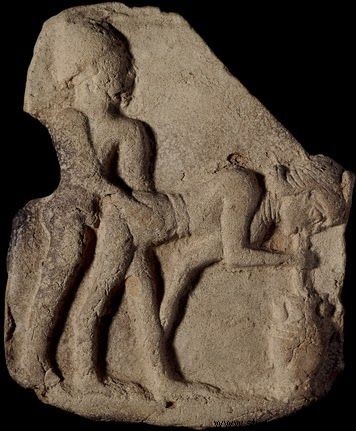They say that the oldest profession in humanity is that of a prostitute, although I have my doubts. If we take a look at the culture of the blackheads, it could be true, since they attached great importance to this occupation, but there is another activity that appears from the first cuneiform tablets. It is about raising the elbow and everything related to this playful activity. It is possible that, since the human being discovered the collection of fruits and seeds, he already began to realize that funny chemical process known as "fermentation".
The Sumerians liked parties. They loved to make love, have fun, sing and drink. And if that drink had any graduation, much better. The Sumerian word for a banquet is “kas-de-a ”, which translates as “pouring beer ”. We can already guess what the main activity of one of those sprees was. The consumption of broths with alcoholic spark included all sectors of society. In the upper class we have the case of the queen Kug-Bau , who was a tavern keeper before accessing the crown, and that of King Ur-Nammu , who between copichuela and copichuela wrote Bacchic poems. Even the gods signed up to have the odd Kurdish. Thus, for example, the goddess Inanna becomes owner of the ME (sacred laws of gods and men) thanks to her making Enki drunk , taking advantage of the cogorza to take off with them to the city of Uruk. In the temples, the gods themselves required that an elaborate ceremonial of food and drink be served to them every day, featuring various types of beers and wines. Even the great superhero Gilgamesh resort to the company and advice of the tavern Siduri .

We have samples of proverbs, some humorous and others sapiential, in which some spirit is used as an example. In this way, someone who was not used to bathing was said to be “the one who serves beer without washing his hands ”. An example of popular joke…
A fox urinated in the sea and said:everything is my urine.
A drunkard urinated in the sea and said:everything is beer
We suppose that, although the Sumerian canals were many and well cared for, the same should not happen with the roads, since a proverb says:“The road is bad; beer is good ”. In another proverb it is stated:“Pleasure is drinking beer; hassle is going on a trip ”. Due to some other aphorism we suspect that commercial fraud was already taking place:“He who drinks beer, drinks water ”.
The Sumerians already knew grape wine, but it was too expensive. Despite this, we know that rich women used it, apart from drinking it, to wash their hair. After several washes, the dark hair acquired a certain shade and/or coppery reflection in the sunlight. What we don't know is what kind of perfume they used to get rid of the smell of wine. Palm wine was also tasted, and the most appreciated was that of Uruk, since that city was famous for its date palm plantations. Palm wine used to be given as a prize to warriors who had excelled in battle, or as an encouragement to special soldiers, such as slingers. A certain aura of virility was attributed to palm wine, and it was an ingredient in potions to engender children.
But of all the fermented broths, beer was the most popular, in part because even the humblest could afford a ration. In fact, in many temples or palaces, beer was part of the workers' daily food rations. The city of Ur was famous for its brewery, which belonged to the sacred precinct. Not only was it exported to distant places, but we know that more than 30 different types were manufactured, among which the diluted stood out. , which was drunk by people who were placed in a prominent place at a banquet or by the ancestors in the ceremony of the Day of the Dead (Kispum ); the clear and the cloudy; the sweet and the bitter; the one with escanda; the black – Apparently, the Sumerians got ahead of Guinness; and some more exotic ones such as dates , the one with olives and the crab . The most curious thing is that we have no idea how they were made, and of some of these specialties we only know their name. The ins and outs of brewing were a trade secret whose violation was punishable by death. Therefore, it is obvious that no tablets have been found with details about the process. It is often thought that we have an example of this in the Hymn to Ninkasi , the goddess of beer, who was described as " the Lady who fills the mouth, born of fresh bubbling waters and quenches her heart «. It is clear that whoever devised these epithets was not in a state to maintain the horizontal correctly. It describes what appears to be a manufacturing method. Experiments have been done reproducing it, such as Tall Bazi , of the Technical University of Munich, or that of the University of Pennsylvania, but the thing is not clear. For historian Peter Damerow , of the Max Planck Institute, all the experiments were achieved by changing part of the process described in the hymn, such as the volume of water or others, of which it is suspected that the person who wrote the text kept some detail as a commercial secret or that the current ingredients are no longer like those of those times. In any case, more than 3.5 degrees has never been achieved, and that was achieved by changing the conditions specified in the table a lot.

And finally, did the Sumerians have bars? The answer is yes. Many women opened a canteen with their dowry assets, selling grape wine they produced on their own land or cheap home-brewed beer. The taverns used to be placed in the ports and in the exits and entrances of the cities, since many of their clients were merchants and travelers. A tavern could consist of a simple room, but there were those that acted as inns, with a second floor where travelers stayed. They could also have a central patio covered with an awning, which allowed customers not only to drink in these premises, but also to attend recitals by harpists or singers. The beer was served in mugs with a conical bottom, since they were placed on boards with holes to support them. Sumerian beer was rich in dregs, so it was tasted through a straw. Every self-respecting Sumerian had his own personal straw, though he could borrow one locally. The rich had them made of precious materials. One of the most famous that we know is the one that appeared in the Royal Tombs of Ur, and that belonged to queen Puabi , made of gold and lapis lazuli. Also, although culturally strange to us, clients could require the services of a “beer wife ”, who were local slaves engaged in prostitution. We have found representations where the two Sumerian hobbies are seen together:drinking beer and making love .

Let us, then, thank the Sumerians for their kind gesture of helping to invent quality wine tastings, and let us say with a jug in hand:«Drunk me? Tururu!" Or said in Akkadian-mousetrap…
Shakiru Ramani? Tururum!
